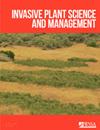固定式土壤蒸腾对抗入侵植物的土壤迁移
IF 1.2
4区 生物学
Q3 PLANT SCIENCES
引用次数: 2
摘要
摘要用蒸汽代替化学熏蒸根除土壤中的外来入侵物种,可以使受污染的土壤得到重新利用。我们在三个实验中研究了土壤蒸汽消毒以对抗入侵植物物种,包括使用原型固定土壤蒸汽装置进行的不同温度和暴露时间的实验。实验包括对大叶羽扇豆(Lupinus polyphyllus Lindl.)、观赏宝石草(Impatiens glandulifera Royle)和野生燕麦(Avena fatua L.;一个种群来自波兰,一个来自挪威)种子发芽的影响,以及对加拿大一枝黄花(Solidago canadensis L.)和波西米亚knotweed(Reynoutria×bohemica Chrtek&Chrtková)根茎碎片发芽的影响。在实验1中,我们测试了64、75、79和98摄氏度的四种不同土壤温度,暴露时间为90秒。在实验2和3中,我们在98摄氏度下分别测试了30、90和180秒以及90、180和540秒的暴露时间,×bohemica的5cm和10cm切割尺寸。我们的结果表明,在75℃(90 s)和98℃(98 s)下,龟头藻的发芽/发芽受到抑制;然而,多叶L.polyphyllus需要更长的暴露时间。虽然在98℃下30 s足以杀死A.fatua种子、s.canadensis和R.×bohemica根茎碎片,但需要180 s的暴露时间才能杀死L.polyphyllus种子。结果表明,通过蒸汽处理可以很好地控制污染土壤中的入侵植物繁殖体,支持蒸汽处理方法作为一种潜在的土壤消毒方法,以防止入侵物种的传播。本文章由计算机程序翻译,如有差异,请以英文原文为准。
Stationary soil steaming to combat invasive plant species for soil relocation
Abstract Eradication of alien invasive species in the soil with steam as an alternative to chemical fumigation may allow contaminated soil to be reused. We have investigated steam disinfestation of soil to combat invasive plant species in three experiments including different temperatures and exposure durations using a prototype stationary soil-steaming device. The experiments included effects on seed germination of bigleaf lupine (Lupinus polyphyllus Lindl.), ornamental jewelweed (Impatiens glandulifera Royle), and wild oat (Avena fatua L.; one population from Poland and one from Norway), as well as effects on sprouting rhizome fragments of Canada goldenrod (Solidago canadensis L.) and Bohemian knotweed (Reynoutria × bohemica Chrtek & Chrtková). In Experiment 1, we tested four different soil temperatures of 64, 75, 79, and 98 C with an exposure duration of 90 s. In Experiments 2 and 3, we tested exposure durations of 30, 90, and 180 s and 90, 180, and 540 s, respectively, at 98 C. Seed pretreatment of 14 d cooling for L. polyphyllus and I. glandulifera, no seed pretreatment and 12-h moistening for A. fatua populations, and 5- and 10-cm cutting size for R. × bohemica were applied. Our results showed germination/sprouting was inhibited at 75 C for I. glandulifera (for 90 s) and 98 C for the other species; however, longer exposure duration was needed for L. polyphyllus. While 30 s at 98 C was enough to kill A. fatua seeds and S. canadensis and R. × bohemica rhizome fragments, 180-s exposure duration was needed to kill L. polyphyllus seeds. The results showed promising control levels of invasive plant propagules in contaminated soil by steaming, supporting the steam treatment method as a potential way of disinfecting soil to prevent dispersal of invasive species.
求助全文
通过发布文献求助,成功后即可免费获取论文全文。
去求助
来源期刊

Invasive Plant Science and Management
PLANT SCIENCES-
CiteScore
2.20
自引率
9.10%
发文量
24
审稿时长
6-12 weeks
期刊介绍:
Invasive Plant Science and Management (IPSM) is an online peer-reviewed journal focusing on fundamental and applied research on invasive plant biology, ecology, management, and restoration of invaded non-crop areas, and on other aspects relevant to invasive species, including educational activities and policy issues. Topics include the biology and ecology of invasive plants in rangeland, prairie, pasture, wildland, forestry, riparian, wetland, aquatic, recreational, rights-of-ways, and other non-crop (parks, preserves, natural areas) settings; genetics of invasive plants; social, ecological, and economic impacts of invasive plants and their management; design, efficacy, and integration of control tools; land restoration and rehabilitation; effects of management on soil, air, water, and wildlife; education, extension, and outreach methods and resources; technology and product reports; mapping and remote sensing, inventory and monitoring; technology transfer tools; case study reports; and regulatory issues.
 求助内容:
求助内容: 应助结果提醒方式:
应助结果提醒方式:


